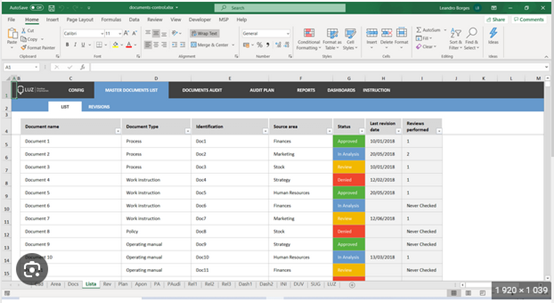Ever wonder how organizations keep their operations running smoothly? Control documents are the secret weapon! These documents act as a roadmap, guiding employees on how to complete tasks, ensuring compliance with regulations, and maintaining high-quality work. In this blog post, we’ll delve into the world of control documents and explain why they’re crucial for any business.
Recognizing what is control document?
Control documents are the meticulously crafted blueprints that act as guardians of order within an organization. They delineate workflows, standards, and protocols across various functions, serving as the guiding light from project management to quality assurance, regulatory compliance, and financial governance. These written procedures, essentially SOPs (Standard Operating Procedures) for various processes, ensure every action aligns with organizational objectives and industry standards. By documenting these procedures, control documents standardize task execution and guarantee everyone adheres to the same set of rules.
Benefits of control document
Control documents offer a multitude of benefits for organizations. They promote consistency by ensuring everyone follows the same established processes for completing tasks. This efficiency translates to time saved, as employees don’t need to reinvent the wheel for each project. Furthermore, control documents play a vital role in regulatory compliance by outlining the steps necessary to adhere to specific requirements. This structured approach helps maintain quality by providing a framework for achieving a consistent standard in the execution of tasks. Finally, procedure documents serve as valuable training materials, helping new employees quickly grasp the organizational processes and procedures.
Types of control documents
There are several key types of control documents used within organizations:
- Standard Operating Procedures (SOPs): These form the foundation of control documents, outlining the mandatory steps for various processes. SOPs can cover a wide range, from manufacturing procedures to standard office tasks and even accounting practices.
- Work Instructions: Providing a more granular level of detail, work instructions offer a step-by-step guide for completing a specific task within the organization.
- Policies: These documents offer broader guidance for overall management of the organization. Examples include human resource policies, environmental policies, and financial policies.
Adapting to the Digital Age: Streamlining Control Documents in a Dynamic Landscape
As businesses embrace digital transformation, Regulatory documents are undergoing a metamorphosis to meet the demands of the digital age. Organizations are transitioning from paper-based documents to digital formats, leveraging document management systems and collaboration platforms. This shift allows for greater accessibility, version control, and real-time updates, ensuring control documents remain relevant and effective in a rapidly changing environment.
Developing Control Documents in the Digital Age:
- Identify the Process: Begin by identifying the process that needs to be documented. This includes outlining the tasks involved, the regulatory requirements, and any relevant stakeholders.
- Create a Draft: Craft a digital draft of the control document that details the procedures to be followed and employee expectations when executing the task.
- Review and Approval: Involve relevant stakeholders, including employees who will be executing the process, in reviewing and approving the control document. Utilize digital collaboration tools to facilitate this process.
- Implementation and Training: Once approved, implement the digital control document within the organization and educate employees on the processes involved. Leverage the accessibility of digital formats to ensure everyone has easy access to the latest version of the document.

In conclusion, control documents are the unsung heroes of organizational success. They ensure consistency, efficiency, and quality by establishing clear standards for task execution. While creating and maintaining them requires effort, the payoff is a foundation for confident work. These documents empower organizations to train and develop employees, adhere to regulations, and prevent errors stemming from inconsistent processes. If your organization hasn’t embraced control documents, consider implementing them to unlock a multitude of benefits. In essence, control documents are the cornerstones of operational efficiency in today’s dynamic business world. By streamlining processes, guaranteeing compliance, and fostering collaboration, they empower organizations to function more effectively and achieve superior results. As businesses adapt to the digital age, control documents will only become more crucial, serving as the bedrock for success in an ever-evolving landscape. Embrace the power of control documents and unlock your organization’s full potential today.
If you want to edit, merge or convert PDF files, you can use our free apps by clicking on this line.
If you want to know more about PDFs please read this Article.
else you can see this article on Wikipedia related to PDF.
